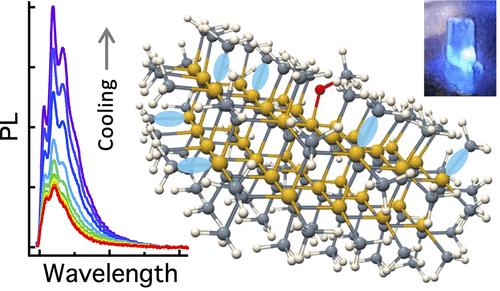表面钝化二维层状碳化硅纳米晶体的温度依赖性光致发光
IF 3.2
3区 化学
Q2 CHEMISTRY, PHYSICAL
引用次数: 0
摘要
将配体钝化的二维层状碳化硅纳米晶体悬浮在交联聚合物中,测量其低温光致发光(PL)。根据样品历史决定的表面化学,查询了三种情况。在处理过程中暴露于氧气中的样品,尽管完全钝化,但仍以非辐射复合为主,显示出广泛的PL和相对较低(10-20%)的量子产率(QYs),随着冷却仅适度增加。相比之下,完全钝化和部分钝化的样品在氧气屏蔽下显示出更强的辐射复合,具有明亮的窄蓝色PL和更高的QYs,在低温条件下显着增加。我们比较这些结果,以室温辐射率测量的大小纯化的部分,源自类似的胶体父母。从低温条件下屏蔽纳米复合材料显示的多峰PL结构来看,我们援引frank - condon论证将明亮的窄发射与表面SiCHx联系起来,而暴露样品中的弱PL与表面桥接氧有关。研究结果对所有形式的纳米结构碳化硅的可见光发射具有重要意义。本文章由计算机程序翻译,如有差异,请以英文原文为准。

Temperature-Dependent Photoluminescence of Surface-Passivated 2D-Layered Silicon Carbide Nanocrystals
Ligand-passivated 2D-layered SiC nanocrystals (NCs) are suspended in a cross-linked polymer to measure their cryogenic photoluminescence (PL). Three scenarios are queried based on surface chemistry as dictated by sample history. Samples exposed to oxygen during processing are dominated by nonradiative recombination despite full passivation, showing broad PL and relatively low (10–20%) quantum yields (QYs) that increase only modestly with cooling. In contrast, both fully and partially passivated samples shielded from oxygen show much stronger radiative recombination with bright narrow blue PL and higher QYs that increase markedly under cryogenic conditions. We compare these results to room-temperature radiative rates measured for size-purified fractions derived from analogous colloidal parents. From the multipeak PL structure exhibited by the shielded nanocomposites under cryogenic conditions, we invoke a Franck–Condon argument to link the bright narrow emission to surface SiCHx, while the weak PL in exposed samples is linked to surface bridging oxygen. The results have important implications for visible light emission from all forms of nanostructured SiC.
求助全文
通过发布文献求助,成功后即可免费获取论文全文。
去求助
来源期刊

The Journal of Physical Chemistry C
化学-材料科学:综合
CiteScore
6.50
自引率
8.10%
发文量
2047
审稿时长
1.8 months
期刊介绍:
The Journal of Physical Chemistry A/B/C is devoted to reporting new and original experimental and theoretical basic research of interest to physical chemists, biophysical chemists, and chemical physicists.
 求助内容:
求助内容: 应助结果提醒方式:
应助结果提醒方式:


